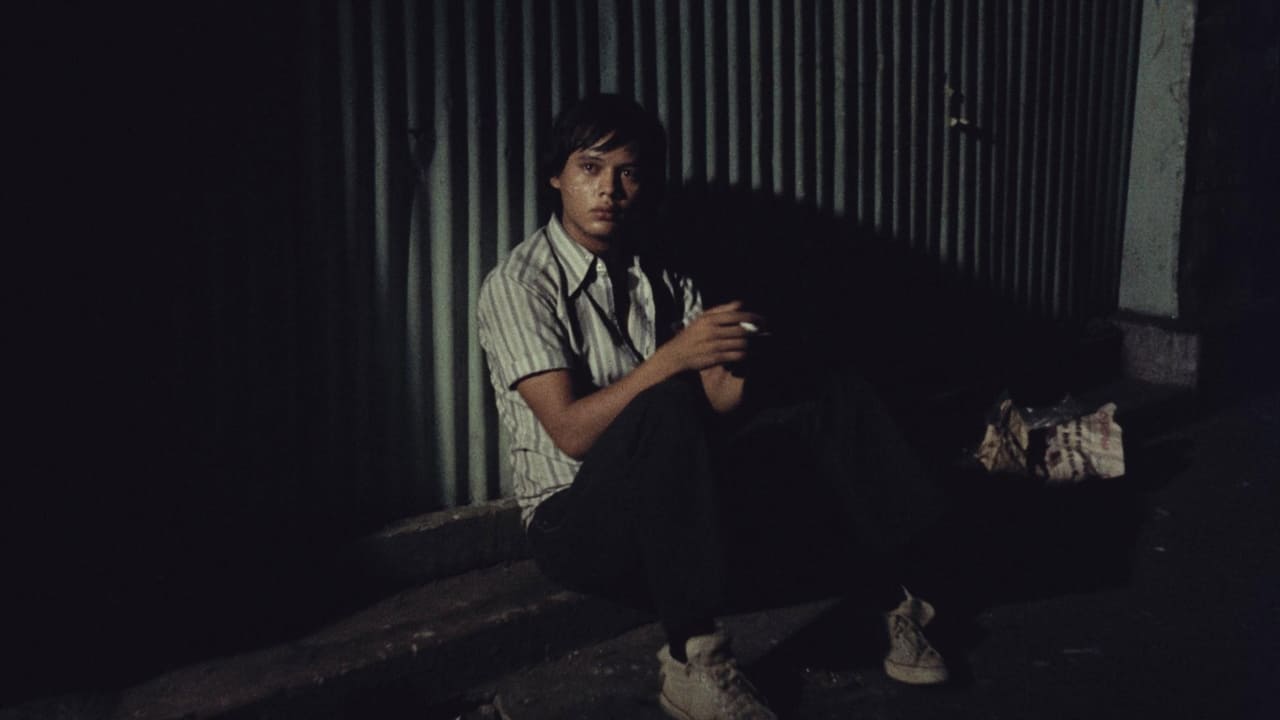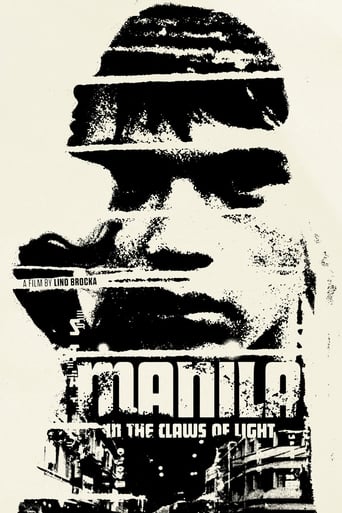GurlyIamBeach
Instant Favorite.
Fairaher
The film makes a home in your brain and the only cure is to see it again.
Mehdi Hoffman
There's a more than satisfactory amount of boom-boom in the movie's trim running time.
Haven Kaycee
It is encouraging that the film ends so strongly.Otherwise, it wouldn't have been a particularly memorable film
Jackson Booth-Millard
This Filipino film, also known as Manila in the Claws of Brightness, is one I found listed in the book 1001 Movies You Must See Before You Die, and in the description I read it is considered by many as one of the greatest films of Filipino cinema, so I was interested to try it. Basically Júlio Madiaga (Bembol Roco) is a simple fisherman from the province on the island of Marinduque, in the Phillipines, who travels to Manila. Júlio appears to be just a young rustic who has to work in order to survive the conditions of the urban jungle, he lands a job as a construction worker, but is not used to such labour, and falls unconscious due to fatigue and hunger. On the site Júlio makes friends with fellow construction worker Atong (Lou Salvador Jr.), who was hired five weeks before him, and another worker advises him unless one has the income to enjoy urban comforts, life in the city can be quite difficult. Júlio slowly begins to observe the harsh reality of society, experiencing extreme poverty, hard luck, and the overbearing need to grind to sustain daily, and even witnesses the accidental death of one of the construction workers. One day, while Júlio and Atong are shopping for clothes in the marketplace, Júlio's attention is caught by a woman reminds him of Mrs Cruz (Juling Bagabaldo), the woman who brought his childhood sweetheart, Ligaya Paraiso (Hilda Koronel), to Manila for schooling. Júlio runs through a crowd and tries to approach the woman, but before he can say anything she screams in distress, he flees to prevent causing a scene, and leaves the marketplace with Atong. Many more chance encounters with Mrs Cruz follow, until eventually Júlio discovers that Ligaya was actually brought to the capital for prostitution, she explains everything when they are finally reunited. Júlio plans for them to get away and return to Marinduque together, Ligaya agrees to meet him at Arranque, however she does not appear at the appointed time. The next day Júlio goes to see his friend Pol (Tommy Abuel), who informs him that Ligaya fell down a flight of stairs, during a struggle with the brothel owner Ah-Tek (Tommy Yap), she died in the night. Júlio is enraged, he sees Ah-Tek at Ligaya's funeral and begins to stalk him, he is successful in dispatching his target. But a mob witnessed what Júlio does to Ah-Tek, they pursue and eventually corner him, the film ends with a slow motion close-up of Júlio's terrified face, just as his assailants are about to strike. Also starring Pio De Castro III as Imo, Joonee Gamboa as Omeng and Julie De Guzman as Asawa. I had to really concentrate to understand everything going, whilst reading the subtitles and watching the grainy imagery, I just about got the grasp of the story, it certainly works well with the melodramatic stuff, exploring the suffering of the disadvantaged, an interesting drama. Worth watching!
lasttimeisaw
The linchpin of Filipino cinema, Lino Brocka's pièce de résistance has been received a well- deserved BluRay treatment, MANILA IN THE CLAWS OF LIGHT is a searing social critique told through the jeremiad of a young fishmonger from a provincial island, Julio Madiaga (the newcomer Roco purveys a deeply affecting performance as a new-in-town tenderfoot) arrives in the big city to search for his childhood sweetheart Ligaya (Koronel), who has been roped into shady prostitute ring from their hometown, only to be overcome by a society infested with moral turpitude and unspeakable vice, belonging to the lowest of the social rung, Julio is inexorably driven to a breaking point when he can only resort to the most radical method to express his fury and desperation, and his ultimate denouement is ominously preordained through the accretion of his violent impulse. Brocka hones a critical eye in presenting the film's urban jungle milieu, shot in actual loci: the harsh conditions of those construction workers, one of them, Atong (Salvador, Jr.) with whom Julio befriends, lives in the squalid shanty with his younger sister (Mendoza) and their bed-ridden father (a landowner expelled out of his own property by wealthy foreigners), adjacent to polluted water, believe it or not, he is in a well-off situation (before the sorry fate catches on with his family); a chock-a-block local market where bargains for goods soon sour into personal attacks and that particular building where Julio suspects Ligaya is interned by a Chinese Filipino Ah-Tek (Yap), the rare seen ringleader, and its neon-lit signboard. His pittance is shortchanged by the sleazy honcho and dangled by the intrusive oldest profession, sacked mercilessly when he is no longer needed, Julio witnesses accidental death befalls on the construction site, the indignant fate befalls on Atong and his family, still, he is too wet behind the ears, succumbs to the skulduggery of a policeman imposer on the street. The crescendo of injustice is which lends this film its cachet and its undimmed relevance, the whole drama probes an unyielding peer into the miasma of unrelieved depravity (just to plumb how pandemic this kind of pathology can reach with a deplorable cri-de-coeur), mirrored through Julio's nostalgic erstwhile memories (ultra-snappy edited), which we all but realize there is no way back. An unexpected sortie in the rough trade virtually becomes the most benevolent segment among a concatenation of threnodies, where Julio reluctantly dips his toes with an epicene punter, which imbues a purely libidinous concern without any creeping malevolence, that is prevalent elsewhere. But, not everyone can find his feet in that line of business, the bar is quite high, actually. An non- judgmental take on the often pejoratively depicted subculture does flag up Brocka's unflinching resolution to spark more social commentary than he would be allowed. Eventually, a chance meeting (a rather oddly conceived occasion wanting more context) reunites the star-crossed lovers, and Hilda Koronel recounts Ligaya's ordeal with palpable poignancy in the lengthy close-ups, only to be tritely weighed down by her inextricable maternal attachment, and spoils their final chance of a happier finale. Upholstered with a perturbing score from Jocson, MANILA IN THE CLAWS OF LIGHT is as harrowing a story as one could envision, but under Brocka's stylish execution, it brims with an urgency to provoke, to shock, to jolt viewers into condemnation, only if he could have curtailed his exasperating anti-China slant, viewed 40-odd years later.
timmy_501
Lino Brocka's 1975 film The Nail of Brightness (aka Manila in the Claws of Neon) is first and foremost a showcase for the social ills of the Philippines, particularly in the urban center of Manila. The film's main character Julio is only recently arrived to the city having left behind his impoverished but relatively dignified and happy life as a fisherman in a small village to find his girlfriend Ligaya who had herself gone to the city at the promise of a job and some educational opportunities only to disappear completely a short time later. Julio's episodic experiences in the city give Brocka a chance to exhibit all sorts of social issues as Julio is robbed of his savings before the film even begins and is forced to seek employment at an unsafe construction site where he agrees to work for a low wage and fails to even receive the meager pay he bargained for; the construction company can get away with this because of a lazy, inefficient government that apparently does nothing for its working class people. As the film continues Julio's misery grows greater; more than one character is forced to turn to prostitution to make ends meet and several major characters are the victims of violent crime.In spite of the didactic nature of the material, Brocka's film is a success because he builds sympathy for Julio through the use of subjective camera techniques. The narrative is peppered with brief, precisely edited flashback shots from Julio's point of view: the result is an unusually powerful evocation of memory. Brocka's subjective cinema transcends the established techniques of social realism and allows him create one of the greatest doomed characters in film history.
Falconeer
Lino Brocka's masterful study of a man's loss of innocence is a centerpiece of great Filipino cinema. The tale of young innocents traveling to the infamous city of Manila, and losing their way, has been told countless times, but "Manila: In the Claws of Neon" was the first, and this unflinching look at urban decay must have shocked people at the time. Bembol Roco is heartbreaking in his role as the small-town laborer who travels to Manila in search of his beautiful girlfriend, who has vanished without a word. With his baby face and puppy dog eyes, he conveys the image of the ultimate naive youth, and Hilda Koronel possesses the same pure quality, as his lost love, Ligaya.Once in the clutches of the decadent metropolis, Julio is forced to either let go of his innocence, or be swallowed up by the ruthless, hardened characters around him. This same theme returns in Brocka's equally powerful "Insiyag." 'Maynila' is more than a study of lost innocence, of course. It is also an honest look at third World poverty, and the desperation that causes people to do things that they might not do otherwise, in order to survive. One of the film's most harrowing scenes features a scared and sickened Julio, lured into working at a sleazy male whorehouse. The character is obviously not homosexual, and being forced into having sex with men is the beginning of his own personal demise. The bloody, shocking climax of this film is one of the most memorable disturbing set pieces in film, and was borrowed from heavily, by Martin Scorsese a year later for his classic "Taxi Driver." Viewed back to back it becomes evident as the scenes in the hallway of the dark apartment tenement are virtually identical. Brocka's vision came first, too bad so few people are not aware of this beautiful film. Thought to be lost, due to improper storage of the film, this has surfaced on the internet, which is where i was able to finally see it. This one, and some other Filipino films are long overdue for restored DVD releases. If you can find it, see it.

